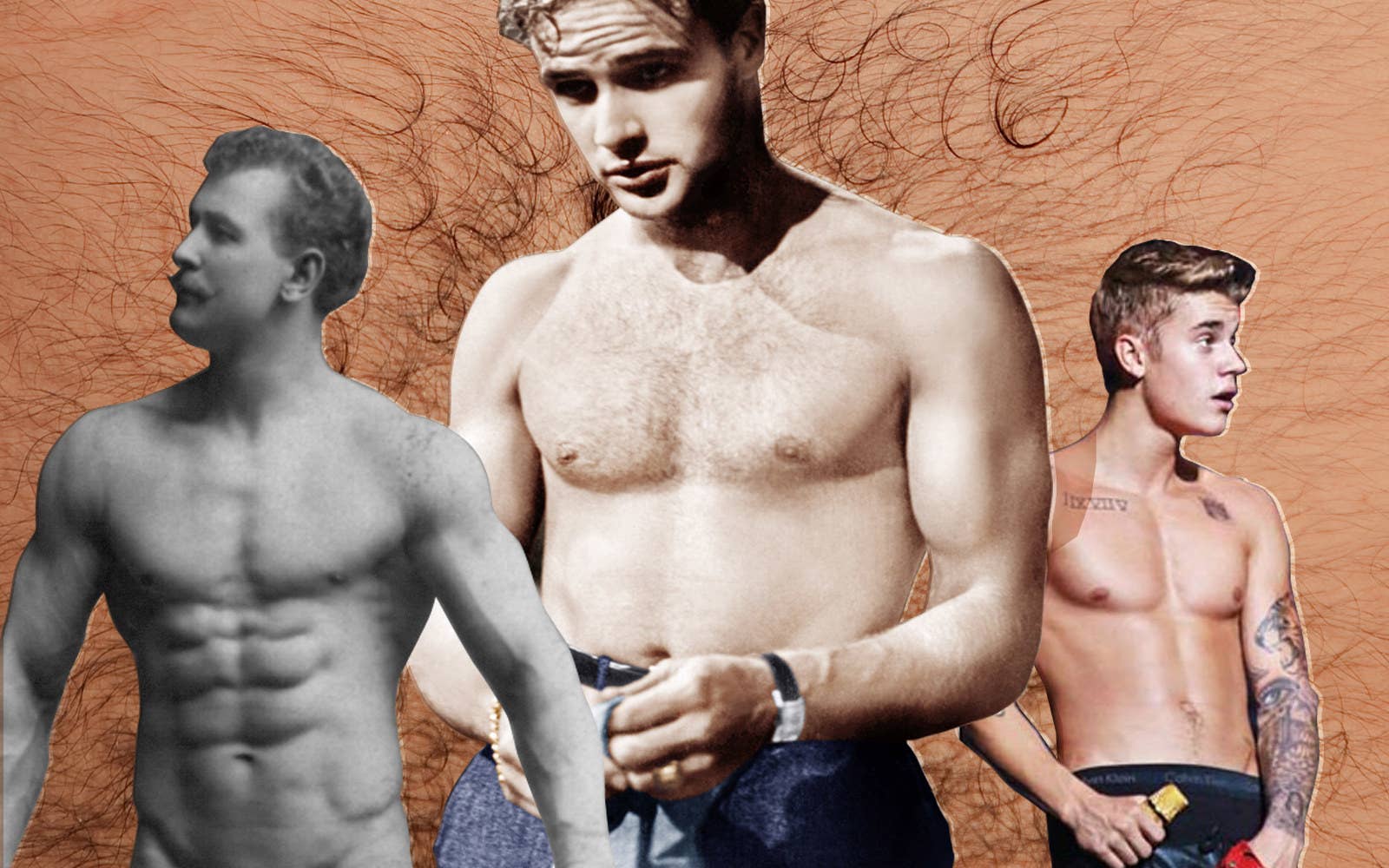
When Sandow the Magnificent went backstage after a show in Washington, DC, the assembled group of senator’s wives and daughters began to tremble. Throughout his 1896 “exhibition” — a public affair, attended by hundreds, during which Sandow had displayed his formidable musculature through a series of poses and feats of strength — they’d kept their faces behind veils. Once backstage, they vowed never to reveal one another’s identities.
The women were nervous but eager, and when Sandow emerged from his ice bath and beckoned them close, wearing only a pair of tight pants, they followed his direction. He invited each woman to come up in turn to “examine” his muscles. “This at first they were loath to do,” the Washington Post reported, “touching the giant gingerly with gloved hands." One woman, practiced in the study of anatomy, began to name each muscle.
“We don’t do this often,” Flo Ziegfeld, who booked Sandow’s shows, explained. “But it’s often hard to refuse ladies. Sandow is always quite willing to oblige them.”
Today, this description could double for a group of women attending a screening of Magic Mike. And while part of the fascination with Sandow was sexual, an even larger portion derived from the spectacle of his powerfully muscled body — a rarity at the time. Sandow wasn’t the first “strongman,” but his celebrity coincided with both the rise of the moving image and continued anxiety over the effects of the industrial revolution on man’s physique and overall health.
Photos of Sandow, sold in “cabinet cards” for 35 cents, spread across the country, while a short film of him played on continuous loop in kinetoscope parlors across the globe. An exquisitely designed magazine, Sandow’s System of Physical Training, went through three printings. He was the first naked chest of the age of the moving image, and like so many naked chests over the next century, he was the right chest at the right time, a nudity that came to mean so much more than the sum of a belly button, some carefully cultivated chest hair, and pair of revealed nipples.
Look at a moment of prominent male shirtlessness and you’ll see a culture trying to sort out its “ideal” chest, but you’ll also observe standards for how men should behave and feel in public and in private, on the job and in the bedroom. When a celebrity takes off his shirt, whether it’s Marlon Brando in the '50s or Justin Bieber in the 2010s, he’s summoning ever-fluctuating currents of masculinity to the surface, to be read, appreciated, and analyzed.
Depending on the era, celebrity shirtlessness has served as an act (a declaration) and a reaction (a means of changing a pre-existing conversation). And after closely studying its public occurrence over the last century, those acts and reactions appear in cycles, like a never-ending feedback loop of naked chests. Each cycle generally starts, as with Sandow, with a declaration of masculinity against a backdrop of fear — that men, and society at large, is becoming feminized in some way. In those cases, shirtlessness provides proof of a robust, potent, masculinity. Once that anxiety is soothed, it’s countered by more emotive, vulnerable, far less terrified — even embracing — aspects of femininity. Sometime in the 1990s, that cycle explodes; as shirtlessness proliferates, its capacity to create meaning disappears.
It seems obvious that a man without a shirt in a national magazine, a widely distributed film still, or viral image on the internet is sending a message about masculinity. What’s less obvious, however, is how those messages have changed — and in an era seemingly saturated with shirtlessness, how much they communicate about the desperate need for masculinity to forcefully, aggressively, unceasingly reassert itself.
When Rudolph Valentino died — suddenly, at age 31 — thousands of women descended upon his funeral, where they provided the archetype for the screaming, overemotional, irrational female fan of the 20th century. The myth of his death has expanded to include the idea that women loved Valentino so intensely that many committed suicide after his death — and, because of that devotion, men came to despise him.
The reality of Valentino’s stardom, and how it incited both great delight and anxiety, is much more complicated — and involved, but did not start with, Valentino appearing shirtless. The Valentino that millions of women (and unheralded men) fell for was wearing a turban, his lids lined, his shirt unbuttoned in a deeply plunging V.
In 1921, Valentino played the titular role of The Sheik, a classic exotic romance with some messed-up gender politics that turned him into an overnight star. It quickly became clear that the bulk of the film’s audience was women — a point repeated in reviews, which then made (more) women go see it, more men stay away, and helped cement Valentino as an object of female desire.
Valentino wasn’t the first male idol — on stage, there had been “mashers,” or matinee idols, for decades; before Valentino, John Barrymore had earned the mantel of “The Greatest Lover Onscreen,” while Wallace Reid was venerated for his strength and handsomeness. But Valentino was more than handsome or romantic. He was sexy, in part because he was Italian — which, onscreen, meant he could play any number of exoticized Others. And while sex appeal should, in theory, make a star’s image more masculine, in Valentino’s case, it did just the opposite.
While sex appeal should, in theory, make a star's image more masculine, in Valentino's case, it did just the opposite.
The 1920s were a particularly volatile moment for representations of the male body: America was still recovering from the aftermath of World War I, which had sent back bodies and minds mangled and deformed; at the same time, the so-called “New Woman” was asserting economic and sexual freedoms. Strong, masculine bodies — like that of Douglas Fairbanks — provided a salve for those anxieties. But Valentino exacerbated them. As film historian Gaylyn Studlar points out, “American men interpreted Valentino not as an ‘athlete’ but as a ‘beauty,’ a decadent foreign specimen” who “confirmed the increasing effeminacy of men and the masculinity of women.” He was photographed in turbans and scarves; his house, photographed for the fan magazines, resembled a boudoir. He was a lover, not an action hero.
Part of the problem was Valentino’s past: He’d made his way to Hollywood by working as a “lounge lizard” and “taxi dancer” — that is, a guy who made ends meet by periodically getting paid to dance with women. That past was compounded by images of his present: Before the release of The Sheik, he had married set designer Natacha Rambova, an artist who, in addition to just generally asserting her independence, supposedly insisted that Valentino wear a gold "slave bracelet" at all times. In this light, it was easy to condemn Valentino for, as Studlar puts it, the “distinctly unmasculine goal of living off millions of female fans who packed the theaters to see him.”
This image was exacerbated in September 1922, when Valentino broke from his studio over artistic control, pay, and say over his future roles. What could have been construed as a masculine break from the machinery of the industry was instead viewed as Rambova controlling influence. Valentino sued for breach of contract; the studio won an injunction that prevented him from being onscreen. Cue: shirtlessness.
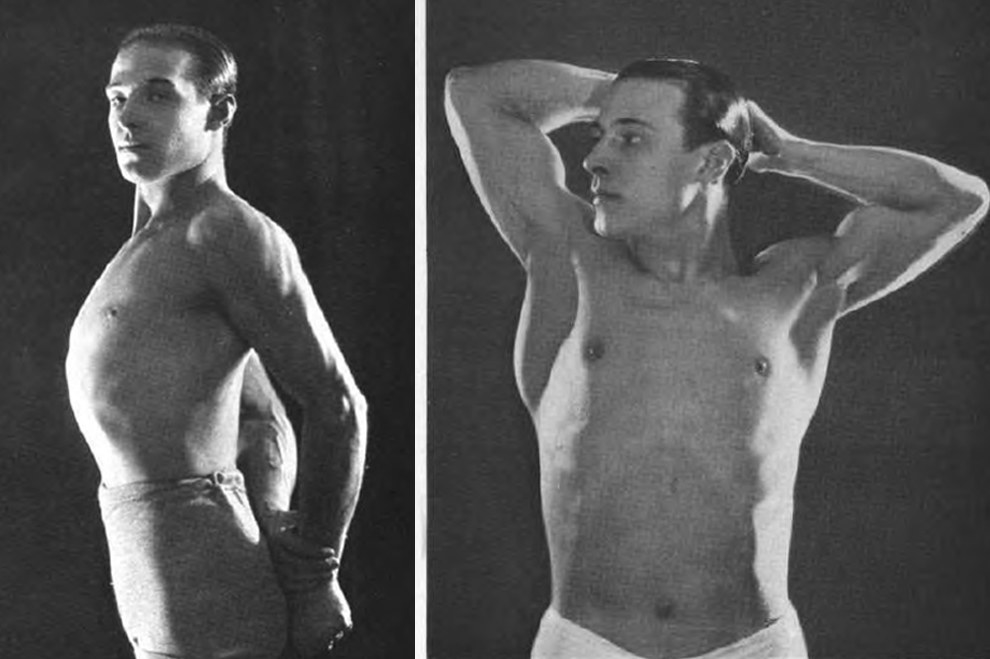
How You Can Keep Fit is essentially the 1923 version of Men’s Health. It was published by Macfadden Publications, which started in 1899 when Bernar Macfadden launched Physical Culture, a Sandow-like how-to magazine that combined tips for fitness, diet, and wellness. Much of the copy reads like any other self-help physical culture pamphlet, with phrases like “The man who is indifferent to his physical health is like a musical instrument that is out of tune” and “Keeping fit is the first law of a successful life." But it also works to frame Valentino and his work on the screen as labor: “It is very obvious that motion picture work requires the highest degree of physical vigor and athletic fitness,” Valentino writes.
But, he was still posing for photos — a pin-up — which, as culture scholar Richard Dyer points out, invokes the dynamic of the (active) looker and the (passive) subject. As a result, many male subjects — especially those for whom masculinity is in question — have attempted to diffuse the connotation of passivity by doing something in photos of them.
The vast majority of images thus depict Valentino in motion, in action, in control. But others, like this one (ostensibly of his back, highlighting the whole of his well-toned backside) feel like a pinup.
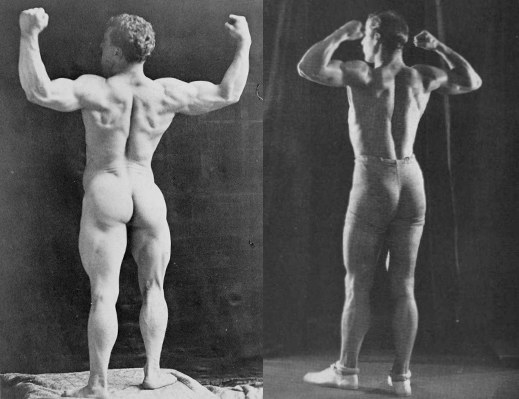
Contrast it with a similar photo of Sandow: Neither are action shots, but in both, the muscles are flexed, highlighting the bodies’ potential for action. Sandow, however, appears like a piece of chiseled marble, an exemplar of the masculine form. By contrast, the image of Valentino is lit in a soft, romantic manner; his skin seems warm and glistening. He’s wearing more clothing than Sandow, yet somehow still seems more sexual.
Ultimately, Valentino’s re-masculating project in How to Be Fit fell apart under the heft of its purpose. The same thing happened with Monsieur Beaucaire, Valentino’s first onscreen appearance after his break with his studio, in which he plays a (periodically shirtless) member of French nobility, but spends the duration of the film in a wig, makeup, and very tight and lacy costumes. It happened yet again in the aftermath of the so-called “Pink Powder Puff Attack,” in which an anonymous Chicago Tribune writer, having found a “powder puff” dispensary in the men’s bathroom, penned an editorial decrying the increased use of makeup by men — which he attributed to Valentino. “It is time for matriarchy if the male of the species allows such things to persist,” the author exclaimed. “Better a rule by masculine women than by effeminate men.”
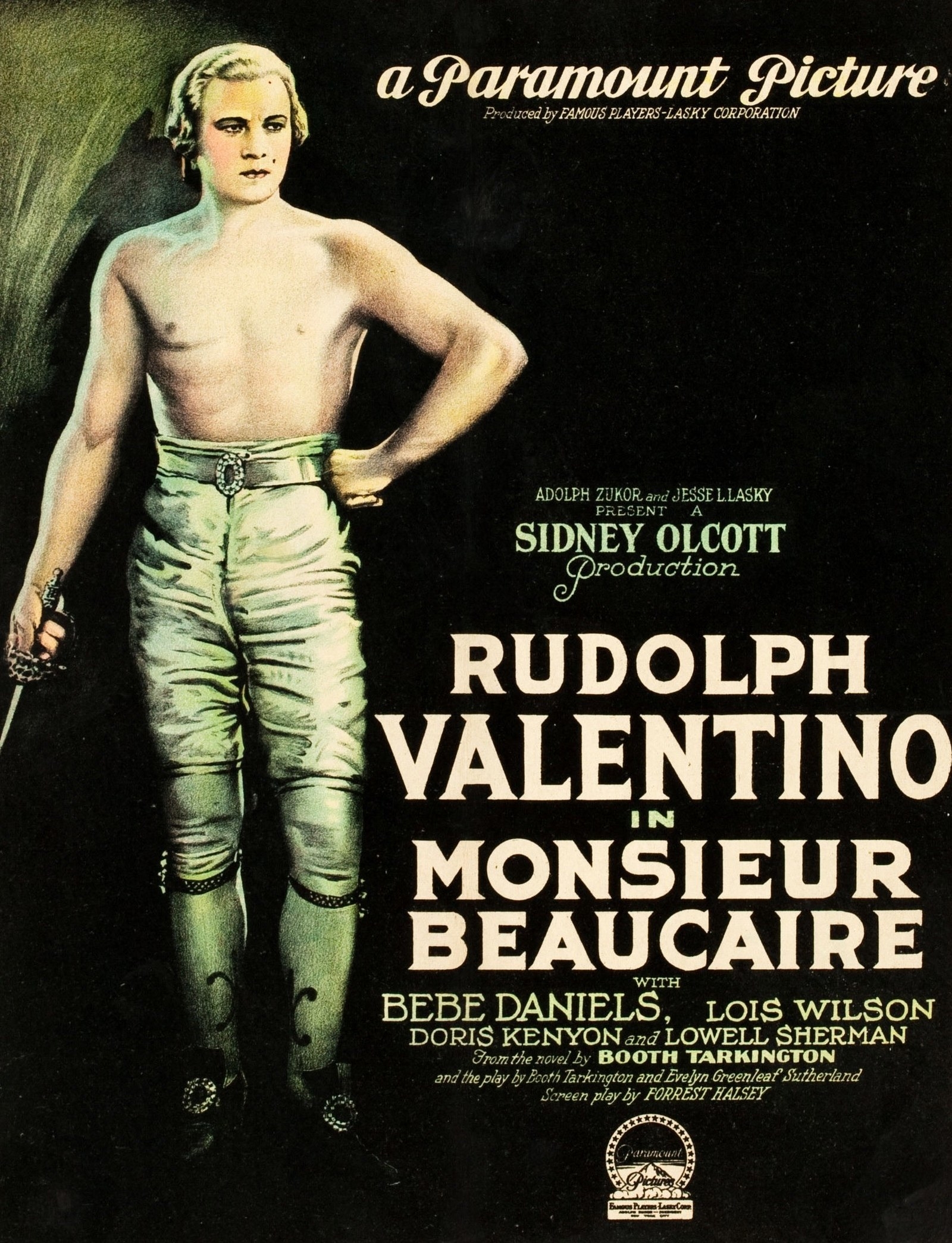
A furious Valentino challenged the unnamed author to a boxing match. The author failed to present himself, but Valentino publicized his training for the match, and was photographed, shirtless, in the ring. With no competitor, he boxed against journalist Frank O’Neill; in the weeks to come, he would celebrate his quasi-victory by appearing in various bars and restaurants, where he attempted to further demonstrate his masculine mettle at drinking, before falling suddenly ill and succumbing, at the age of 31, to complications resulting from severe gastric ulcers.
The masses of women crowding the streets of New York followed, and so too did the Valentino legend: of a man beloved by women, but also of one brought asunder by his attempts — many of them bare chested — to confirm his masculinity. That image would hover over the next 20 years of Hollywood, as dozens of swarthy male stars were introduced to the public with the question, "Is he the next Valentino?"
It was simple for the gossip press to declare Clark Gable, who first entered the studio system in the early ‘30s, as the heir to Valentino: A 1931 column wondered “Have the movies found, in Clark Gable, another Valentino? Every time Gable appears on the screen, an electric shock runs through all the female hearts for miles around.”
Like Valentino, Gable was framed as an object of girlish adoration: a piece in New Movie Magazine declared “outside of Valentino, no star but Clark Gable ... has appealed to so many women.” But even as the studios planted stories of his ability to attract women, they also labored to assure readers that men also loved him. “I have never heard a man say he did not like Clark Gable,” a three-page spread in Movie Classic proclaimed. “He may be the king of Great Lovers to the women, but he is also Hollywood’s most doughty and popular he-man!”
Just years after his death, Valentino had become one of the most iconic and beloved stars of Hollywood — but no studio or star wanted to reproduce his deeply feminized image.
Instead, the reliance on shirtlessness returned. For Gable, it shows up about halfway through It Happened One Night — a film that would go on to sweep the Academy Awards and launch him to stardom. In the scene, Gable and the bashful, proper Claudette Colbert are forced to share a hotel room, where he offers a monologue about undressing while undressing himself. The scene flips the usual norms of the gaze of cinema, which was succinctly described by art historian John Berger as “Men watch. Women watch themselves being watched.” In this scene, the audience watches as Gable himself is watched, quite closely, by Colbert’s assessing eye.
Most of the incidents of filmic shirtlessness to that point had been utilitarian: a man in action, sporting, or swimming. But here was a modern man disrobing in front of a modern woman in a hotel room. Any potential feminization is undercut, however, by Gable’s broad shoulders and deep, booming voice — the sort that Valentino, who’d only appeared in silent films, could never use to declare his manliness. Gable had a swarthiness to him, but he was born in Ohio, not Italy: There was none of the feminized ethnic Other in him. Instead, he could be purely masculine — as Movie Classic declared, “Men sense sincerity in Clark Gable, a real interest and liking for the things that are men’s things.”
After It Happened One Night, no one dared call Gable a second coming of Valentino. From then on, fan magazine writers would compare new and upcoming stars to Gable himself. According to Hollywood lore, Gable’s lack of undershirt in the scene — an anomaly at the time — resulted in sales of undershirts plummeting 75%. This figure has no source, but the extent to which it has been repeated speaks to just how iconic the scene became.
Gable’s unrepentant masculinity in film became the cornerstone of his image — cemented, five years later, with his turn in Gone With the Wind and his service in the Air Force during World War II. Yet after the end of the war, Gable and the other aging greats of classic Hollywood would struggle to maintain their box office clout as a wholly different mode of acting, and emotive masculinity, came to the fore.

There were plenty of men who took off their shirts onscreen between Gable and Brando, but once you watch Brando do it in A Streetcar Named Desire, it’s difficult to keep them in mind. The high-waisted trousers, the broad shoulders, the wisps of chest hair — it’s all similar to Gable in It Happened One Night. But when Gable took off his (pressed, dress) shirt, it was done methodically — a businessman taking off his clothes before bed. By contrast, Brando’s shirt is stained with sweat and filth. He asks Vivian Leigh if she’s alright with him “getting comfortable” as his shirt sticks to him in the Southern heat. She turns away, but peeks back around after he’s flung his shirt away. The camera joins Leigh in lingering over his shirtless chest, his bulging biceps.
Brando had cultivated his body with this specific look in mind, working out daily at the gym to cultivate the physique that would best match the combustive masculinity of Stanley. Costume designer Lucinda Ballard shrunk Brando’s white T-shirts to fit tightly around his biceps — a dramatically different look than the loose-fitting white T-shirts most men wore, which extended nearly to the elbow. She also tailored his jeans while they were wet, pinning them especially close in his groin and ass area. Brando, for his part, refused to wear underwear. When he saw the completed look, he purportedly shouted, “This is it! This is what I’ve always wanted!”
Brando’s Streetcar physique was highlighted in various shades of undress in Julius Caesar and Viva Zapata!, but even when he remains fully clothed — as he did in both The Wild One and On the Waterfront — the memory of shirtlessness seeps through. There’s something different about the way the camera lingers on his body, similar to the way it lingered on Paul Newman’s body in The Long, Hot Summer. It feels shameless, in a way. This sort of shirtlessness wasn’t a momentary spectacle, but something around which entire narratives bended.
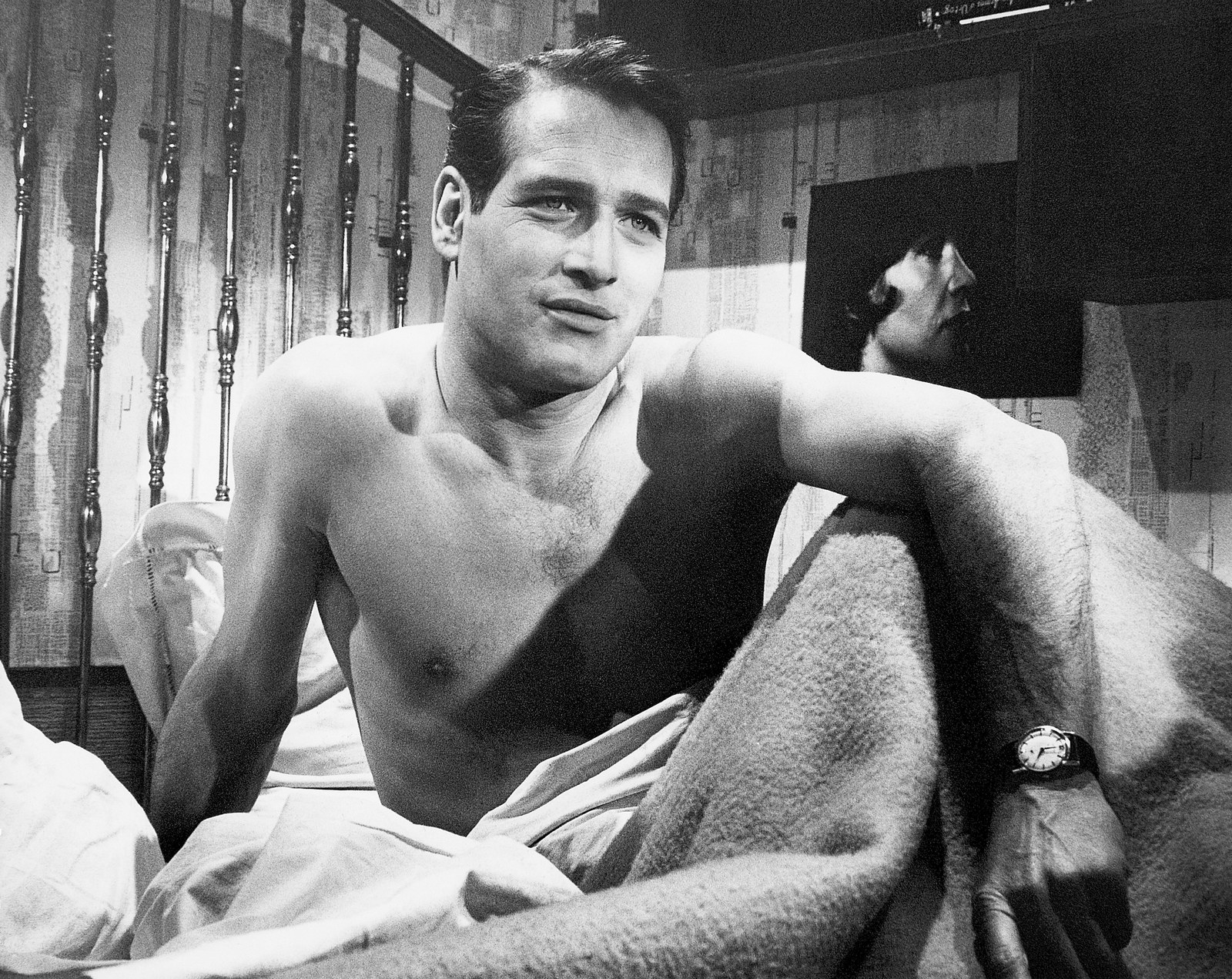
That erotic, desire-leaden attention did not feminize them — in part because they were antidotes to the so-called "Man in the Gray Flannel Suit," the “organization man” stifled by banality and conformity in supposed suburban bliss. Similar to the turn of the century, when anxieties about the feminized man had slowly infiltrated American culture, the ‘50s vibrated with worry about the way that the white-collar workplace was making men into passive participants in their own lives and families.
After World War II, middle-class women were out of the workforce and back in the home, but they were figured as demanding and suffocating, henpecking their husbands and sons into submission. These figuratively castrated men were the hapless butt of jokes in the original Father of the Bride, or tethered to the home, like James Dean’s father in Rebel Without a Cause, so pitiable in his apron. Brando’s star image, crystallized in the moment he took off his shirt, was an antidote to all that.
The tales of Dean’s obsession with Brando are legion, but Dean was no Brando. Brando was seven years older, and while his Method acting was incredibly emotive, he didn’t cry quite like Dean, whose pained wails in Rebel resonated so powerfully with teens in part because they were those of a boy embroiled over the process of becoming a man, not confounded by his life as one.
An early spread in Life magazine depicted Dean generally looking sad in both Indiana and the streets of New York. There’s a set of photos of Dean from 1955 with a cowboy hat and without a shirt, but when he was killed in a car crash in September 1955 at the age of 24, it was the images of him glowering, not goofing around shirtless, that became emblematic of his image — fetish objects of the millions of teens who coalesced into the cult of Dean.
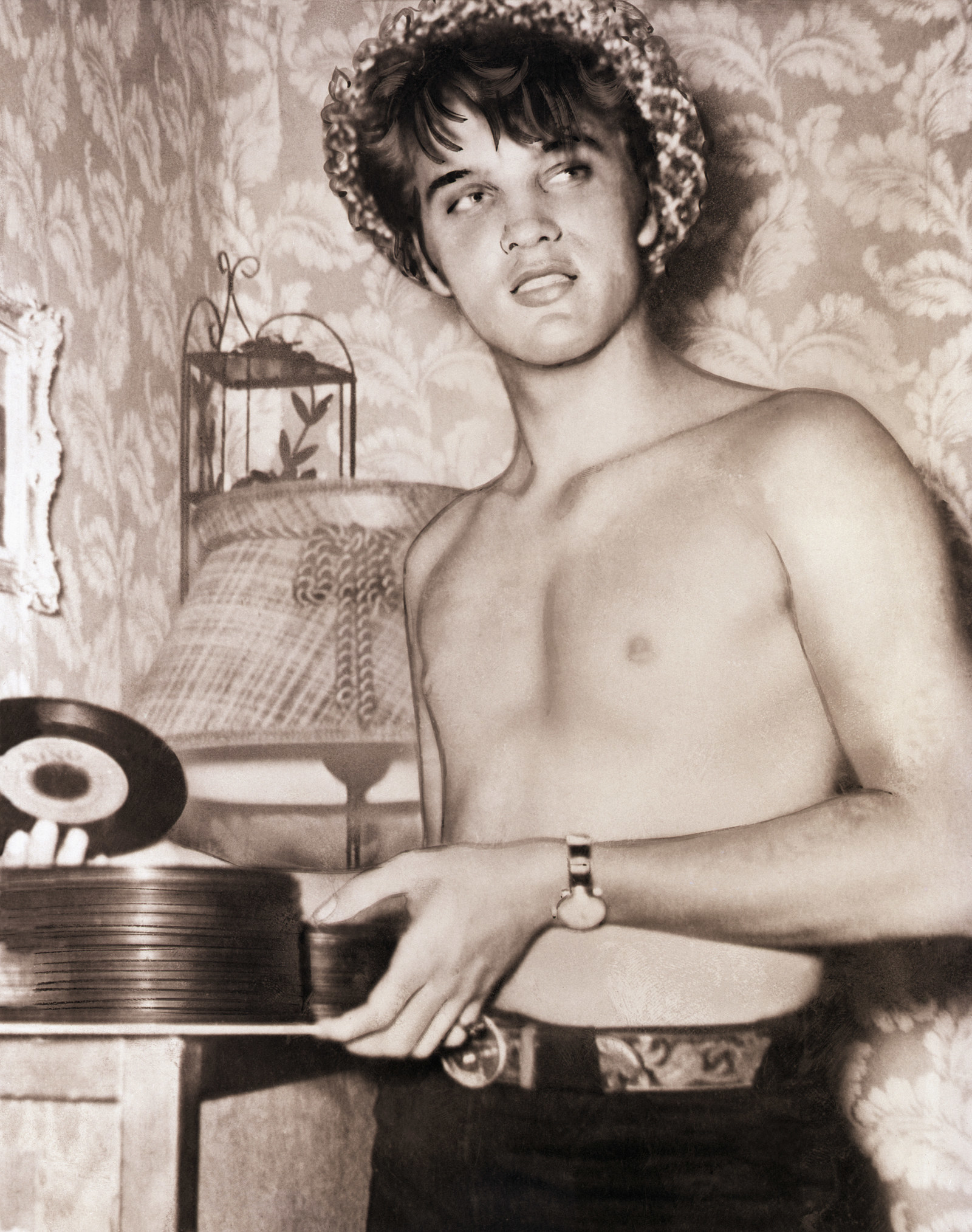
Elvis Presley was one of those fans. In 1955, he told one photographer that he’d “made a study” of both Dean and Brando; he supposedly watched Rebel Without a Cause so many times he had whole swaths of dialogue memorized. Elvis would channel a mix of that emotionality and a potent suggestion of sex into his music, accentuated by his famously swiveling hips. His appeal was degraded and decried — in part because his music and affect borrowed heavily from African-American musical traditions, but also because his fan base was represented as young, female, and hysterical.
Like Valentino, the anxiety Elvis provoked was directly linked to the way he challenged norms of masculinity. He dyed his luxurious hair black; he pomaded it into a pompadour; he sculpted his sideburns; he loved blue eyeshadow and mascara and ruffled shirts and the color pink. He pouted. He danced. Guitarist Scotty Moore, once remarked, upon seeing Elvis in one of his costumes, “I thought my wife was going out the backdoor.” And all across the United States, teens adored him for it.
A 1956 Life photo spread for “A Different Kind of Idol” was typical of the new photojournalism of the period and the post-studio system coverage of male idols. Before, fan magazines would rely on photography facilitated by the studios themselves — most often shot in the studio, but, when they did go to the star’s home, scenes were carefully curated to present a specific understanding of the star and his or her meaning.
Life Magazine’s focus on photojournalism helped change the aesthetic with which the “real lives” of the stars were represented. Gone were the carefully posed garden shots; in their place, dozens of action shots of the stars at home, making their way through crowds, with their friends, in repose. This style was facilitated by lighter weight, portable cameras, as well as the post-studio system understanding of stardom. While some star personas, like those of Rock Hudson, remained incredibly polished, others — like those of Brando, Dean, Newman, and Presley — were rooted in an ideal of authenticity. And no magazine better reflected that non-posed, non-performative ideal than Life.
Elvis didn't present brute strength like Brando, but he was a raw conduit of virility.
Amid shots of his emotional fans, men getting their hair “duck tailed” to resemble Elvis’s, and town officials discussing how to “curb” his appeal, Elvis dons boxing gloves and spars with high school friends, kisses the cheeks of lucky admirers, and sits, shirt off, in a recliner as he listens to his own music. The month before, Lloyd Shearer had photographed Elvis in a similar shirtless pose in his Memphis hotel room, reclining against a bed — only this time, he stared at the camera, his gaze languid. His flesh seems soft and undeveloped; his shirt off not to show off, but because of the heat. It reads like a piece of erotica.
That was the indoor Elvis. Outdoor Elvis didn’t present brute strength like Brando, but he was a raw conduit of virility: “He was the master of the sexual simile, treating his guitar as both phallus and girl, punctuating his lyrics with animal grunts and groans of the male approaching orgasm," George Melly writes in Revolt into Style. "He dressed to emphasize both his masculinity and basic narcissism, and rumor had it that into his skin-tight jeans was sewn a lead bar to suggest a weapon of heroic proportions.”
Such virility, at odds with the so-called “containment culture” of the early days of the Cold War, was a provocation. Television censors tried to blunt it by shooting him from the waist up on The Ed Sullivan Show; moralists tried to curb it by decrying his capacity to incite “dishonesty, violence, lust, and degeneration.” But there was a far simpler way to way to “fix” the problem of Elvis: Send him to war.
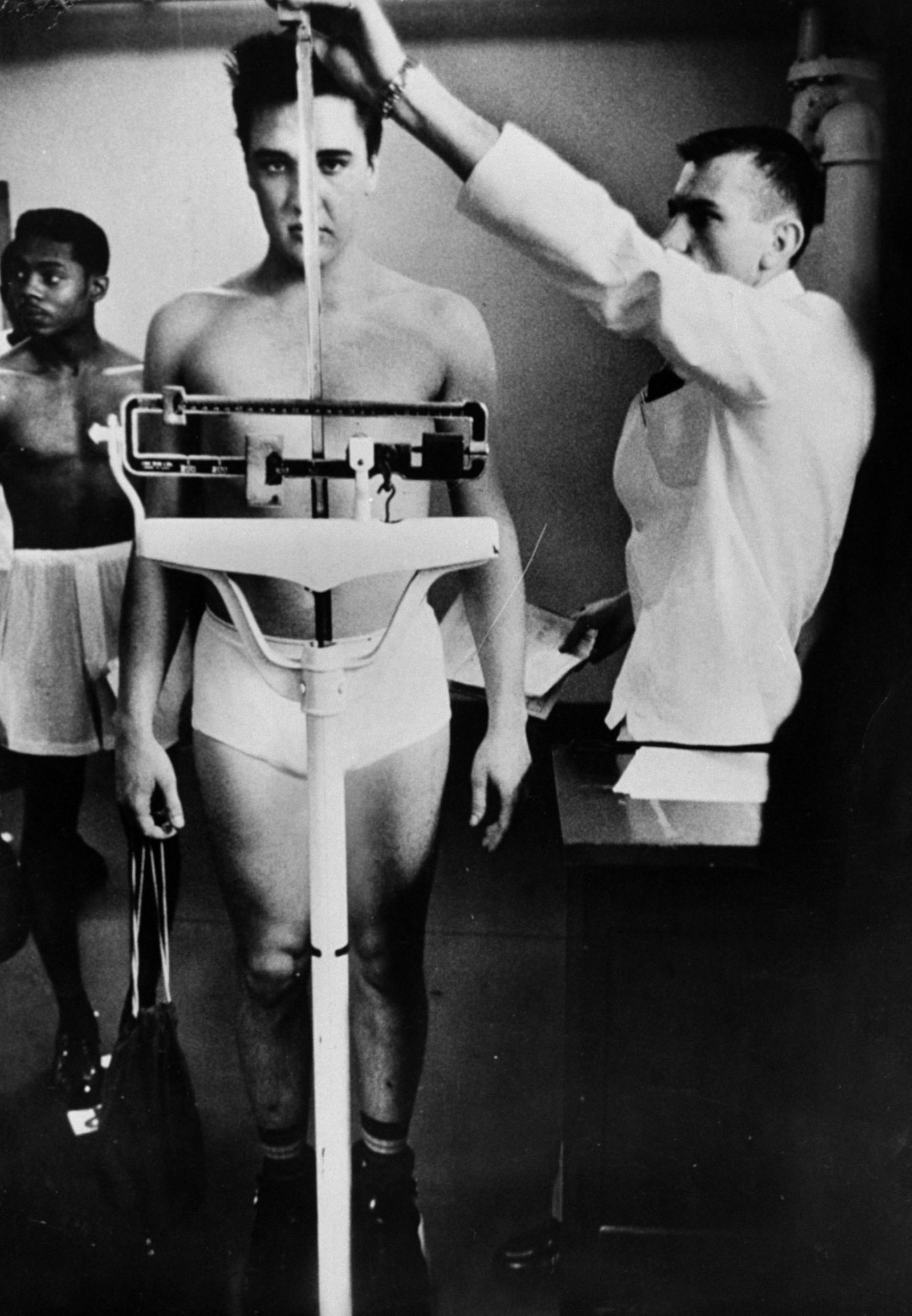
Two days after Elvis appeared on The Ed Sullivan Show for the third time, the draft board classified him as “1-A” and eligible for service in the Korean War. As with previous eras, in which many of male and female stars were enlisted in “special services” to perform and otherwise entertain the troops, Elvis could’ve avoided combat entirely. But Elvis’s manager, the famously controlling Colonel Parker, didn’t want his star performing for free. He also understood that Elvis’s popularity was reaching a saturation point, and a backlash was brewing: What better solution than removing Elvis from public view?
It would take more than a year for Elvis to leave for service, but when he did, his fans dubbed it “Black Monday” and declared it a day of mourning. As he submitted for his preliminary Army physical in Memphis, Texas, Presley was photographed in detail. The resulting spread, presented in Life as “Presley’s Private Debut,” includes images of Elvis getting his hair cut and lugging his Army duffel in uniform. But it led with a full-page print of the picture above, his slightly muscled, ghostly white frame stripped to his white briefs.
His flashy clothes and makeup are gone. His gaze seems like a confrontation, not an act of seduction. The subtitle of the article — “Star is shorn, a new GI born” — emblematized what the Army was intended to do to Elvis’s image. As Erika Doss, author of Elvis Image: Fans, Faith, & Image, explains, “Almost overnight, Elvis the Pelvis became Elvis the G.I., a responsible citizen a regular Joe who could stand up to military discipline.” Gone was the gender play and ambiguity; in its place, a conservative, uncomplicated understanding of masculinity and duty.
After Elvis returned in 1960, all that had distinguished his original image was muted, a memory of its distant self. He still worked to appeal to the same young female fans, but it was through a far more traditional form of masculinity — much more Clark Gable, much less Valentino.
The hips still swiveled, the lip still curled. But the threat was gone, and that image — as near to naked as most male stars had ever been in the pages of a magazine — had ironically marked the beginning of its disappearance. As John Lennon declared years later, upon hearing the news of Elvis’s death: “Elvis died the day he went into the Army.”
As the ‘60s progressed and the ethos of the sexual revolution took hold, one might think that depictions of the shirtless male would become even more erotic, more stirring. Instead, they were absent of the emotionality, tenderness, and volatility that had hovered like a thunderhead over the shirtless images of Brando and Elvis. As cultural historian Susan Bordo explains, “the vigorous male animal,” so perfectly embodied by Brando and Newman, “morphed into that being, well-known to us today, whose world (except for the quick lay, the dead girlfriend, or the barely visible wife) is almost exclusively that of car chases, earsplitting explosions, contests with other men.” The most obvious and influential of these men? Steve McQueen.
Just look at how Life introduced “the bad boy’s breakout” to the public in 1963: “His mixed-up past is mirrored in his hardened face and in the wary look in his eyes ... His childhood delinquencies had landed him in a school for troublemakers, his behavior in the Marines landed him repeatedly in the brig.” McQueen was to appear the following month in The Great Escape — the film that would launch him, definitively, to stardom — and the spread, for which photographer John Dominis spent three weeks following McQueen around the Sierra Madre Mountains, the Mojave Desert, and Big Sur, California, was a declaration of tough-guy manhood.
Every photo in the spread catches McQueen in action: shaking hands, playing with his malamute, racing his motorcycle, wincing in pain from the blisters on his hands from racing, taking off his leather jacket. In the lead shot, he’s caught looking at the camera, but still in action — his face blank, in the midst of his constant motion of manhood. Even in the domestic space, he’s abundantly masculine: laughing while his young son wrestles with him, relaxing in a sulfur bath with a bottle wine, a cigarette hanging out his mouth and his wife’s bare back visible from behind.
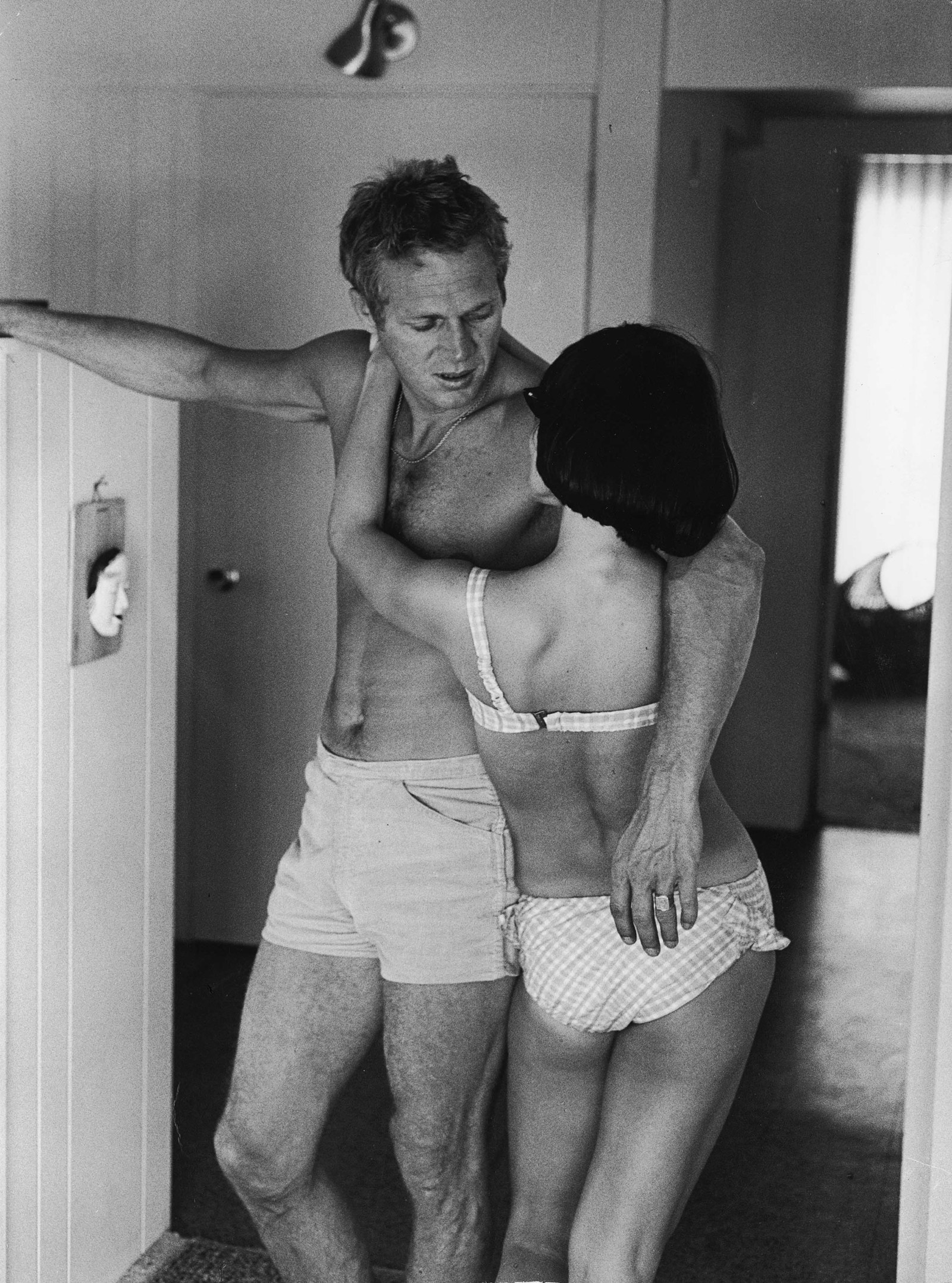
Years later, Dominis would publish a book with the best shots from the 40 rolls of film he took over those three weeks, including a shot of McQueen stripping to nothing before jumping into a pool. But for the Life spread, there was but one shirtless shot.
This image is shirtlessness shorn of its external complications, masculinity reduced to its least complicated essence. In it, we see McQueen’s bare chest, his short shorts, his muscular thighs, his arm draped around his wife, whose back is to the camera. Her arms are around his neck, her hips shifted to the side, dressed in a bikini. She is, in a word, draped. The caption says they’re chatting “affectionately,” but his look is that of one who consumes, not invites; we, as viewers, are firmly on the outside.
It makes sense that that sort of masculinity resonated amid the flurry of the sexual revolution: Second-wave feminism was gaining its footing, but the left still fetishized the all-powerful, sexually dominating male. And yet: Just as McQueen’s popularity was reaching its zenith in films like The Thomas Crown Affair and Bullitt, a more emotive, yet no less destructive, avatar of masculinity was taking off his shirt for a New York photographer.
The “Young Lion” sessions, taken by Joel Brodsky, would supply photographs for a number of Doors albums and compilations, including the back cover of The Doors, in which a shirtless Jim Morrison appears in spotlight, the disembodied faces of his three bandmates floating in the background. But the truly iconic image, later dubbed "American Poet," was one of dozens Brodsky took at the end of the shoot. Morrison’s hair is shaggy and long — the opposite of Steve McQueen’s closely shorn, military-style look — and he wears a necklace gifted to him by Gloria Stavers, the editor of 16 Magazine who’d previously written up her encounter with Morrison in highly suggestive terms.

In some of the shots from that day, Morrison glowers, purses his lips, and contorts his body. But only one shot made its way into the pages of the Village Voice, which would incite a frenzy of 10,000 copy requests from readers. There are the obvious comparisons to Jesus, with his outspread, crucifix-like arms, and an eroticism to the wisp of chest hair, the notable pecs, the visible ribs. But it’s the stare that makes the photo: an invitation, but a dangerous one.
It perfectly matched the tenor of Morrison’s voice, his desire and loathing for the women who contributed to the potency of his image as a sex symbol. Morrison’s “love-hate relationship with his teenage fans (groupies or not) reflected a deep ambivalence about his own erotic power,” Ann Powers writes in her forthcoming book, Good Booty: Sex and Love, Black and White, Body and Soul in American Music. “It manifested in abuse rooted in his mental instability and misogynistic tendencies, and possibly his resentment about having to perform heterosexual heroics when his own desires ran across a wider spectrum. But his performed boorishness, coupled with unabashed displays of deep vulnerability, also unraveled conventional masculinity in powerful ways.”
Being a sex symbol isn’t feminizing if people think you’re having a mind-boggling amount of sex.
“Morrison never really looked that way again,” Brodsky would later say. “I think I got him at his peak.” He also caught Morrison in a mode that would go on to influence the way rock musicians comported themselves on and off stage — and ushered in the age of the shirtless rock musician. Robert Plant, Alice Cooper, the Allman Brothers, Grand Funk Railroad, Iggy Pop, and many more posed in various shades of shirtlessness for album covers and photo shoots, an expression and exploitation of the effusion of sexual explicitness, ambiguity, and “pornographic aura,” as Powers puts it, that had began to infuse the early ‘70s.
It was a return to look of pre-Army Elvis — the hot pants, the suggestive shrieks, the toying with the phallus — but instead of marrying the young groupies that crossed their paths, the way Elvis did with Priscilla, these men fucked, abused, and otherwise denigrated them. They couldn’t be feminized by their hordes of female fans, after all, if they were treating them like disposable objects.
If a musician wanted to tap into that sort of rock star image, he could work hard to cultivate a bad reputation. Or he could just pose for a photo on the cover of the most popular rock magazine in the world. Which is why, in 1972, David Cassidy — best known as the guy singing catchy, mildly saccharine love songs on The Partridge Family who bewitched entire arenas of young girls — posed shirtless for Rolling Stone.
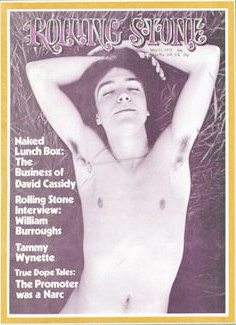
At this point, Rolling Stone was known as an “underground” magazine, with none of the gloss and mainstream appeal associated with it today. But it had an authenticity and distinct authority within the world of music — both of which Cassidy, who had been denigrated for his soft, poppy, unabrasive style — coveted intensely. The profile that accompanied the cover is a classic of the Rolling Stone genre, highlighting Cassidy’s frustration with his image, the persistence of his fans, and his treatment by the music establishment at large.
“I had some hostility towards you,” Cassidy told profiler Robin Green, “and I still do probably. The magazine is very anti-me and anything I have going for me — like commercialism and all that stuff. I’m afraid of it ‘cause it attacked me. It put a knife into me ... So I take the knife out and I manage myself up and I say, OK, now I’m afraid of that, right? That stuck me once and shoved me once and it wasn’t really even about me. So I’m very defensive about Rolling Stone. I guess that’s kind of a fucked way to be ... But I would really dig reading something about me that wasn’t, you know, the same old bullshit.”
The profile is not, as Cassidy would say, the same old bullshit. But it does point to what Cassidy’s appeal had been to that moment: As his manager explained, “He projects a joyful, affirmative sexual appeal. He does not infer destruction. Like Sinatra in the Forties he has that touchable, vulnerable, clean attraction.”
But Sinatra had never posed shirtless, his pubic hair showing, within the pages of a magazine. Cassidy was clearly trying to complicate his image — revising it through the unvarnished look at his drug use, but also through the photos, which aligned him with the potentially threatening masculinity of the rock gods like Morrison who’d come before.
Cassidy’s shirtless strategy was markedly different than that of Burt Reynolds, who, in 1972, agreed to become the first Cosmopolitan centerfold. It wasn’t an attempt to revise his image, but to make one anew: At the time, Reynolds was a relative unknown, shuttling between low-profile television and low-budget film projects for the better part of a decade. The year before, he’d been cast in the film adaptation of the best-selling novel Deliverance, but the film wouldn’t come out until that July.
Cosmopolitan, headed by Helen Gurley Brown, had become a handbook of sorts for the liberated career woman. It was sex-positive, man-positive, and, in 1972, looking for a new gimmick. They found it in the centerfold: If women were seeking equality, then they should get naked men too, right? The success of the centerfold would help pave the way for Playgirl, which would pair nudes and erotica with highbrow political and cultural commentary and attract millions of readers.
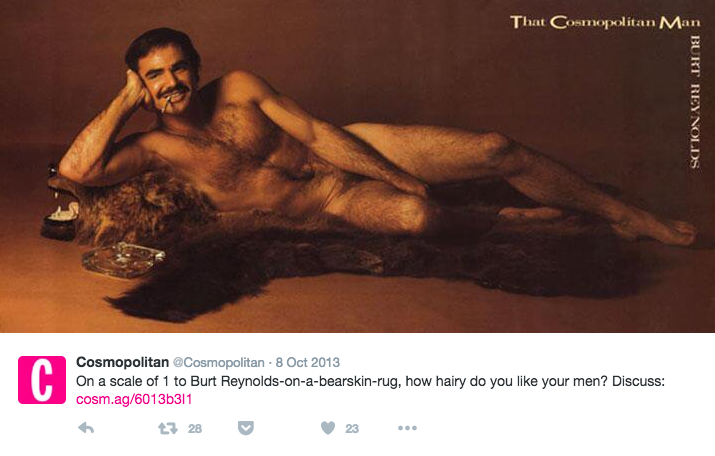
But before all that, there was Burt Reynolds’ naked body on a bearskin rug. The centerfold established Reynolds as a sex symbol — and played as crucial a role in launching him to stardom as his performance in Deliverance. And at the time, Reynolds wasn’t ashamed of it — at least not totally. “What the hell, it’s intended as a put-down of Playboy, which I hate,” he told a young Roger Ebert. “They ought to sell it with raincoats.” He agreed to the shoot in part because he didn’t have any publicity stills: “So what can I lose?” he thought, “If something comes out good, I can always crop it, right?"
The shoot took place at a famous Italian photographer’s studio, and when he arrived, it was freezing — “so if they want pictures of my thing, it’s a bad day” — but they put him on the rug and gave him some booze and a Saint Bernard. “The guy’s shooting away, and after a while it begins to seem like fun,” Reynolds continued. “Oh, well. As long as you’re reliving each moment to the fullest, what the hell difference does it make? They showed me the photographs, and I chose the one they’re going to use. It doesn’t show anything, just a little pubic hair.”
Here, Reynolds highlights his agency over his own objectification: He got to pick the photo; he did it not because he wanted to show off his body, but because he thought it could serve a utilitarian purpose. Gurley Brown shored up his masculinity in a different way, telling gossip columnist Joyce Haber, “He’s got a beautiful body. He’s adorable, and I can assure you he’s totally heterosexual.”
“He’s got a beautiful body. He’s adorable, and I can assure you he’s totally heterosexual.”
Reynolds also deflected the notion that being a sex symbol would somehow feminize him, admitting, “I expect to be the butt of jokes. Every time I get on a plane now, broads whistle. But that’s okay. I happen to like women.” Like Morrison and other shirtless musicians, being a sex symbol isn’t feminizing if people think you’re having a mind-boggling amount of sex.
The image itself conveys a similar understanding of the intersection of masculinity and nudity: Reynolds’ body is covered in hair — a departure from shirtless celebrities of the past, and a strong signifier of maleness, further accentuated by his presence on the bear rug. And while he’s posed like a pinup, his smile suggests he’s in on the joke of his objecthood. With a cigarette dangling from his mouth and his forearm suggesting the size of his penis, he’s man enough to deflect whatever connotations of passivity the pinup might otherwise imply. He doesn’t look directly at the camera, but off in the distance; he’s not focused on one woman, but the crowd.
That attitude fit with both the sex-positive approach of Cosmo and, by extension, the surging sexual ideologies of the age, in which birth control was readily and widely available and stigmas around premarital sex were continuing to fade. Reynolds’ centerfold — and those that followed, including football player Jim Brown and future Massachusetts Sen. Scott Brown — proposed equal-opportunity nudity as a stand-in for the larger, unachieved issues of feminism, like equal pay. But it also helped normalize a certain amount of skin in mainstream publications, including an upstart that would go on to forever alter the magazine business: People.
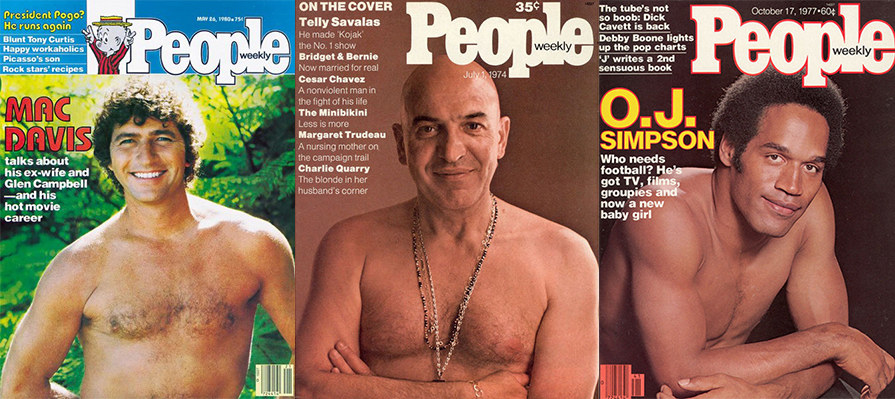
In 1974, Time Inc. launched People with a simple premise: The magazine would highlight whoever was doing the most remarkable things, famous or not. From the beginning, the magazine labored to differentiate itself from the fan magazines, which had turned into fawning fluff, and the tacky tabloids, like the National Enquirer, filled with tales of Elvis’s decline. They lowered their reading level to appeal to the largest number of readers possible, and engineered each issue to be just long enough to be consumed in a single sitting.
Unlike Life, which had gone under in 1972, People’s aesthetic wasn’t photorealism, but something more soft and welcoming, treading the knife edge between pablum and accessible. They featured anyone they thought their readers would find interesting, spanning the realm of entertainment, politics, and everyday people. The shirtlessness on the cover wasn’t intended to sexualize, but to normalize.
Gossip columnist Joyce Haber had touched on this normalizing capacity after Reynolds first appeared in Cosmo, when she surveyed a who’s who of women in Hollywood to see what celebrity men they’d most like to see naked. There were the expected answers of Paul Newman and Steve McQueen, but the No. 1 request was Richard Nixon, followed closely by Henry Kissinger.
No one really wanted to see Nixon’s bare thighs, of course: They wanted to see him laid bare. Following Watergate, the trustworthiness of the government, and authority figures in general, were at an all-time low. So what better way for the president of the United States to communicate his dedication to transparency and honesty than to appear on the cover of People in a swimming pool with his shirt off?
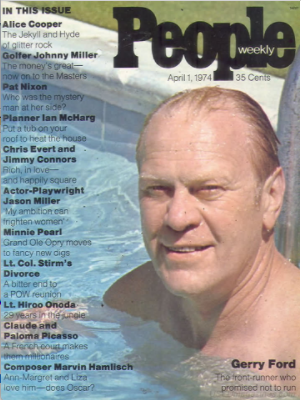
In an April 4, 1974, cover of People, newly appointed Vice President Gerald Ford’s thinning hair is slicked back; beads of water still cling to his face. But he looks straight at the reader with a soft smile that says, Trust me. Subsequent shirtless cover photos — of Telly Savalas, star of Kojak, quarterback Joe Namath, Billy Joel, and O.J. Simpson — helped round characters and celebrities known for a different sort of performance into people: A football player became a sex symbol; a bald, brash cop on TV showed his vulnerable side. Each man is lit in a way that makes him seem cheerful, welcoming, like he’s about to give you a bear hug, not try to get in your pants.
And while Simpson and Namath have the musculature of athletes, a different, hardened, hairless body ideal was about to supplant them and the rest of the semi-Buddha-bellied men who adorned the cover of People. There are hints of this new ideal in 1977, when Arnold Schwarzenegger appeared as the Cosmo centerfold, his biceps the size of his face, and his book, Arnold: The Education of Bodybuilder, became a best-seller. As with Sandow at the turn of the 20th century, Schwarzenegger’s he-man physique became popular in part because of larger anxieties — in this case, the continued threat of the Soviet Union — undulating beneath American culture.
It’s no accident that two of the major franchises of the early ‘80s, Rocky and Rambo, both star Sylvester Stallone and his own version of the “hard body” — well-trained, impenetrable, invincible, just like America’s conception of itself in contrast to a Communist threat.
You can see the influence of this body in the transformation of John Travolta between Saturday Night Fever, released in 1977, and its sequel, Stayin’ Alive, released in 1983. Much like Valentino and Elvis before him, Travolta’s character in Saturday Night Fever is dedicated to dance and his look; as Bordo explains, “never before Saturday Night Fever had a heterosexual male movie hero spent so much time on his toilette.” In one scene, he appears in his black briefs, with the slightest of love handles; his body is made for dancing, not physical labor.
When Travolta signed on for Stayin’ Alive, so too did Sylvester Stallone — as director. Stallone showed Travolta a picture of a classical statue of a discus thrower, and asked “How would you like to look like that?” Travolta jumped at the chance, religiously following a seven-month training program that, as Bordo puts it, “literally redesigned his body into a carbon copy of Sly’s.” He appeared with that body, his abs like washboards, on the cover of People and Rolling Stone, an underground magazine no more, with new muscles oiled and glistening.
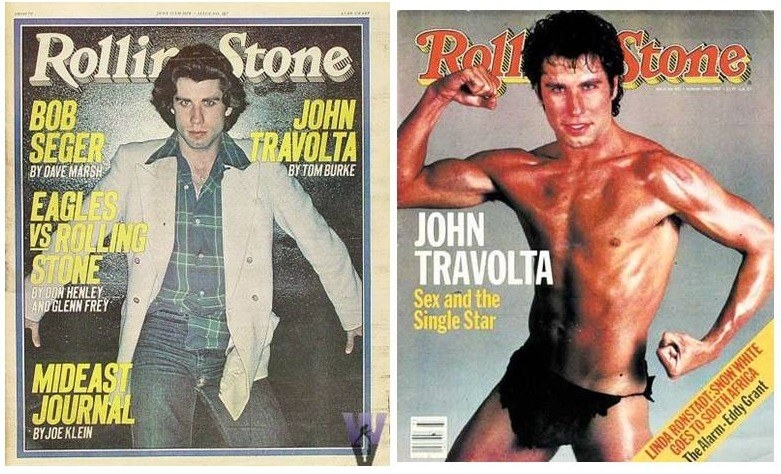
That physicality, and its accompanying understanding of masculinity, would flourish through the ‘80s in the film careers of Stallone, Schwarzenegger, Bruce Willis, and Mel Gibson, in an updated, pumped-up version of the McQueen attitude toward action and women of the late ‘60s. But those bodies, at least in shirtless form, disappeared entirely from the covers of magazines. When People launched its “Sexiest Man Alive” feature with Gibson in 1985, he was not only wearing a shirt, but was also photographed from the shoulders up. It’s as if these men’s strength was so substantially evident in the films dominating the box office that magazine covers were better used to show their “softer” side: like Gibson in a button up, or Willis in a suit.
But just as the McQueen uber-masculine hard body ideal gave way to emotional, glowering rocker and the cheeky, sex-positive centerfold, the hard body — like the politics of Reaganism it so deftly embodied — were gradually usurped by a new sort of shirtlessness. One that, in truth, wasn’t new at all: the bad boy.
In 1992, Luke Perry, bad boy of Beverly Hills 90210, did his best James Dean on the cover of Vanity Fair; in 1995, Johnny Depp appeared shirtless, tattooed, and smoking on the cover of Esquire — one of the few shirtless men ever featured on a men’s magazine’s cover — in a profile about “breaking hearts and furniture.” Brad Pitt, whose image was rooted in his abs (which first launched him to stardom in Thelma & Louise), his serial killer role in Kalifornia, and his sad-sack gloom in Interview With a Vampire, appeared straight-up shirtless in Rolling Stone and on the front of Vanity Fair in a ripped shirt, his hair flowing behind him, under the headline “BRAD BOY.”
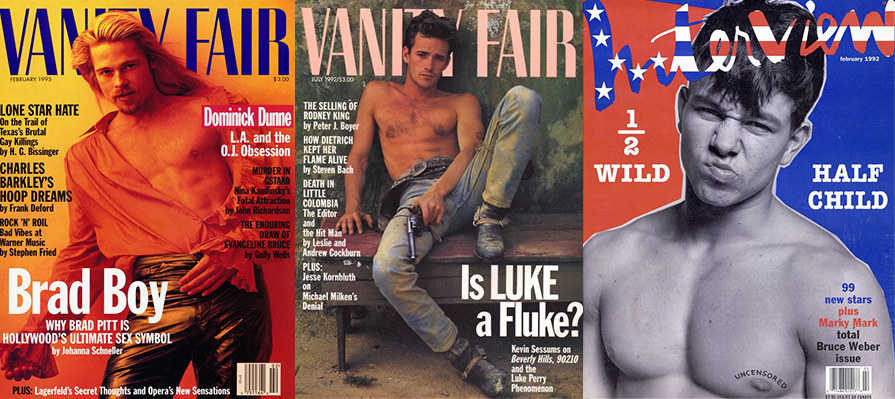
These covers offer a hybrid of the ‘50s era Brando emotionality and the ‘80s hard body: bodies posed in emotionality, but obviously the product of work in the gym, hewing, however slightly, to the newfound ideals of muscular definition.
Everyone loves to remember Pitt’s beautiful, star-making abs. But the body everyone in the early ‘90s was talking about belonged to a petulant young rapper, the kid brother of one of the members of the most successful boy band since the Monkees. His name was Mark Wahlberg, but everyone knew him as Marky Mark — and as covers of Entertainment Weekly and Interview would declare, he was both a “Boy Toy” and “1/2 Wild 1/2 Child.”
Wahlberg had grown up in and out of trouble on the South End of Boston, and that delinquency would define his early image much like it did for Steve McQueen before him. Along with his brother Donny, he was originally part of the New Kids on the Block, but dropped out to become a hip-hop artist of sorts, amassing his “funky bunch” and signing to Interscope Records. In 1991, the video for “Good Vibrations” — in which Wahlberg appears shirtless throughout — dominated MTV.
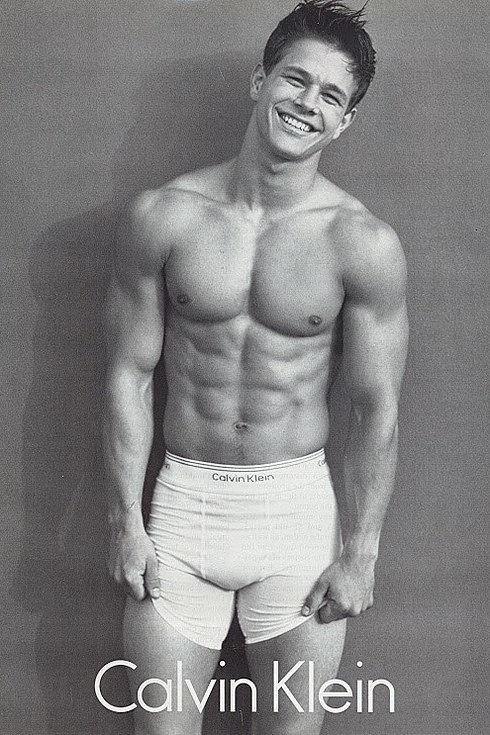
While Wahlberg’s rapping was passable at best, Calvin Klein saw that his body, and the incorrigible swagger that accompanied it, was Wahlberg’s real asset. Klein, like the rest of the fashion scene, had been fetishizing the male body for decades: According to Klein’s biographer, in 1974, Klein was walking through the Flamingo bar in New York, filled with the beautiful bodies of gay men, and had an epiphany: “He realized that what he was watching was the freedom of a new generation, unashamed, in-the-flesh embodiments of Calvin’s ideals: straight-looking, masculine men, with chiseled bodies, young Greek gods come to life.”
Men with this look would fill Klein’s advertisements through the ‘80s, but reached their apex in Wahlberg, whose look, Bordo writes, “embodied a highly masculine aesthetic that — although definitely exciting for gay men — would scream ‘heterosexual’ to (clueless) straights.”
In a series of ads, Wahlberg cycles through the various components of shirtless masculinity: In one, he grabs his crotch and signals his virility; in others, Kate Moss clings to him like an adornment. But in the third, and most famous, he laughs, as if he’s reveling in his own body.
This image is a counterpoint to both the bad-boy confrontation of Walberg's other magazine covers and the melancholy of Depp and Pitt. It telegraphs what Wahlberg’s career would eventually become, but it also signals the deluge of shirtless bodies, and the posture that accompanied them, that was to come with the turn of the 21st century — one that played to both gay and straight desires, that made the chisel of the abs deeper, the run of the cum gutters more profound, the look of the face more ambiguous, and the meaning all the more diffuse and largely illegible.
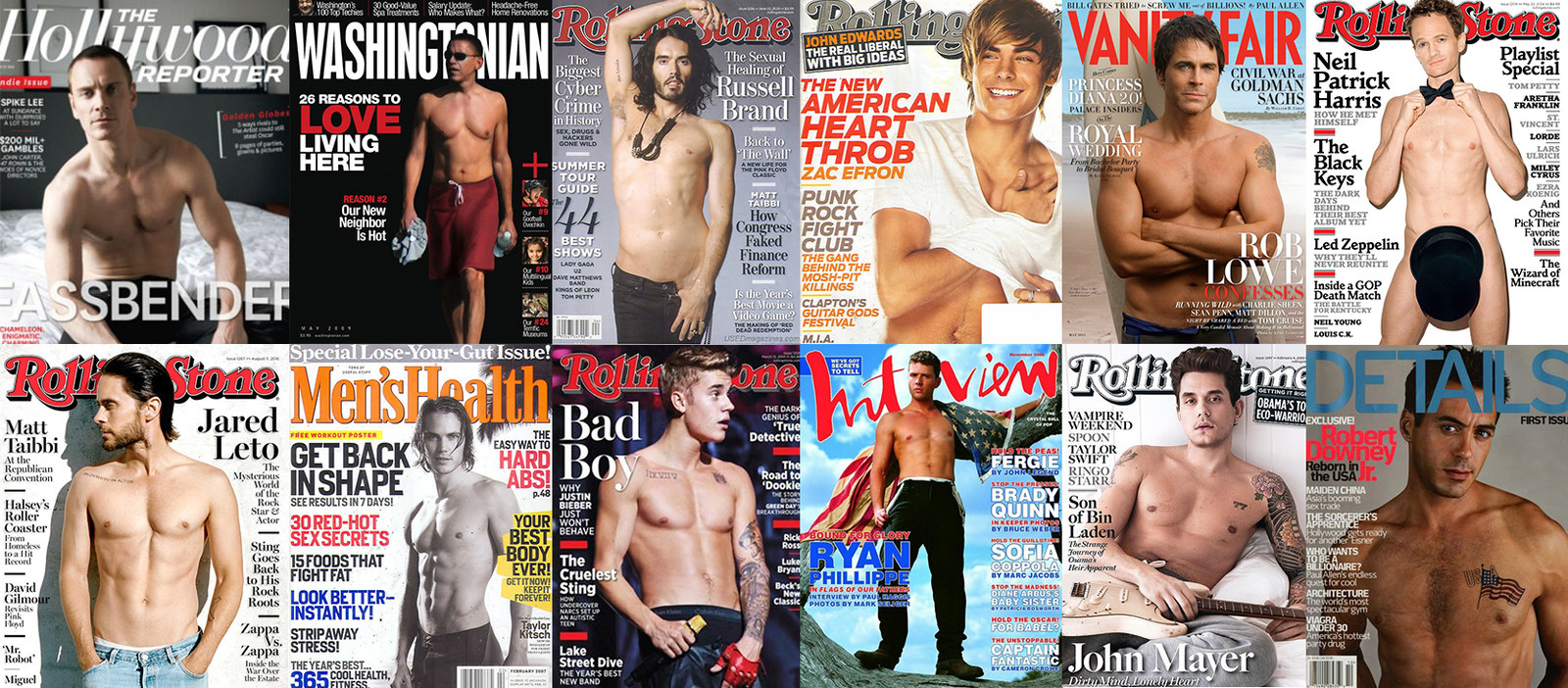
Over the last 20 years, shirtlessness became the norm on the cover of Rolling Stone, it infused Vanity Fair, it helped define the aesthetic of Details, and in 2014, it even came for Barack Obama. A set of unwritten rules established themselves: A guy could be shirtless on a men’s magazine if it was to show off “healthy” living or if a woman was clinging to him; a guy “caught” in the act of taking off his shirt (Ashton Kutcher, Zac Efron) was declaring his transition to sex symbol. It could be used to declare an otherwise uninteresting star worth your attention, or reassert the masculinity when it had come into question; on very rare occasions, and only if the star was a comedian, it could be wielded as a punchline.
But more than anything, the bevy of shirtlessness helped establish a standard bare chest to which all — whether actor, athlete, comedian, or president — should aspire. It doesn’t matter if you’re gay or black, a middling television star or an aspiring method actor: The number of tattoos changed, but the body, and the one-dimensional idea that it connoted, remained remarkably similar.
Blame Abercrombie & Fitch, which flattened all that was exciting and intimidating about Wahlberg’s look by multiplying it across a lifestyle brand, or Men’s Health, with its endless iterations of the black-and-white pose of perfection. Blame David Beckham, whose precise grooming and immaculate musculature became the avatar of metrosexualism. Blame online porn, which helped standardize a vision of what a man who gets to fuck looks like while he’s doing it, or the continued rise of the internet and video games, which incited new anxieties about what happens to the male body as it wastes away in his mom’s darkly lit basement.
Whoever you blame, the “good” body — that is, the sort that’s always ready to take off its shirt, whether for the photographer, in the club, or, today, the Instagram photo — became ubiquitous, a stand-in of sorts for the “have it all” man. It’s not enough to be smart, or excel at work, or be funny; you must also have visible, chiseled, perfected abs.
In many ways, men are simply facing the same prospect of holistic perfection that women have for years.
In many ways, men are simply facing the same prospect of holistic perfection that women have for years. Over all the decades when men were getting selectively partially naked, women’s bodies were always on display, whether through tightly fitted or barely-there clothing on the covers of magazines or completely nude in the pages within. Today, the pursuit of bodily perfection — through waxing, hairstyling, dieting, and the focus on muscularity with no actual utility — has been normalized and, with the gradual decline in homophobia, destigmatized.
Vanity and grooming are cool, no longer rejected as the provenance of gay men and the racialized Other. “Back when bad bodies were the norm,” Fortune’s Alan Farnham wrote in 1996, “money distinguished male from male.” But now that muscles are of equal worth to money, the market for products catering to “male vanity” has exploded, topping $21 billion in 2016. Meanwhile, 90% of male college students wish they were more muscular.
But these shirtless bodies aren’t doing anything new. Justin Bieber’s Calvin Klein ads are a simple reproduction of Marky Mark’s; Shia LaBeouf channels Steve McQueen in Interview; Mario Lopez copies Burt Reynolds; Men’s Health is a rotating cast of Sandows and hard bodies. And while every moment of shirtlessness in the past was, in some way, a reaction to the ideological work that came before it, each of those moments also revised or retrenched understandings of masculinity. For all the ubiquity of the contemporary shirtless man, he is bereft of meaning, a copy of a copy of a copy, chiseled stone that’s hollow beneath.
There are, of course, exceptions: like whatever complexity is going on with Bradley Cooper’s shirtlessness on the cover of W, or the image of Tiger Woods, taken years before his various sex scandals, but placed on the cover of Vanity Fair at the peak of them as a sort of retrospective commentary on the darker masculinity within. Those instances feel like small revelations, secrets badly kept that become, just for a moment, freely told. But they are eclipsed by endless, increasingly indistinguishable shots that don’t offer a different model for masculinity to readers so much as suffocate them with a single one.
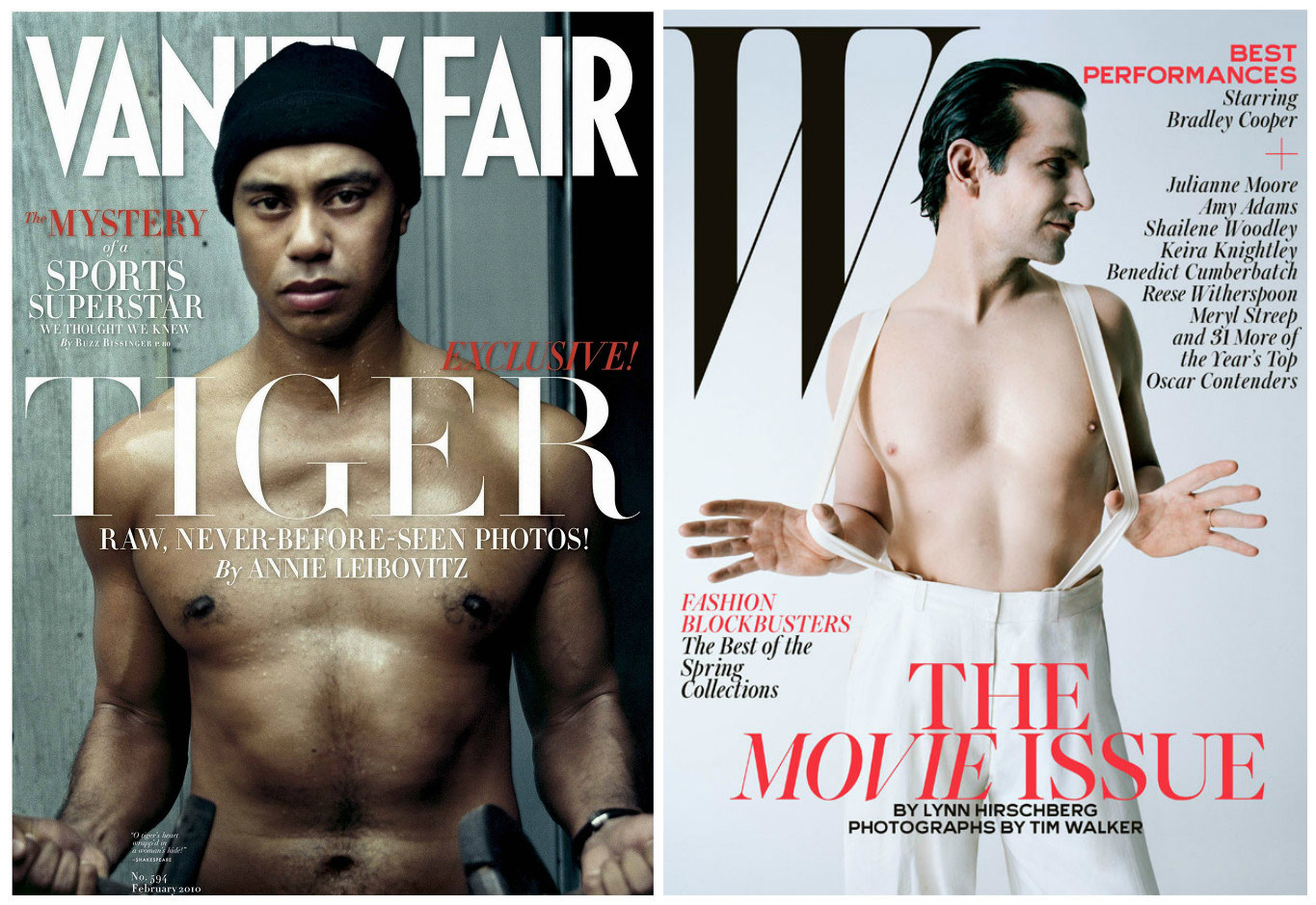
This piece began as a meditation on Justin Bieber and Orlando Bloom’s penises, which took center stage this past August. One was revealed to shore up notions of a teen idol’s continued transition into bad-boy manhood, the other, at least in part, to reinvigorate interest in his fading image. Perhaps the penis is the only way a male star can differentiate himself these days — at least in the way in which taking one’s shirt off did before.
But a penis is just a penis; it can be bigger or longer or hard or flaccid, but as the proliferation of dick pics has demonstrated, it lacks the polysemy, the sheer multiplicity of meanings, of the removal of the shirt. Both say "Look at me," but only one says it in a way that’s interesting. The dick pic can be sad or disappointing; it can signal brazenness or indignity. But the penis simply cannot be inscribed and read with the richness of the bare chest, which proffered competing visions of what a man could be and what other men and women should desire.
Shirtlessness has lost its aura: the thing that made it feel like art and, as such, worthy of our attention and analysis. When everyone is expected to flaunt it, perhaps that means no one should. Which isn’t to mean we should usher in some era of buttoned shirts or performative modesty, but to remind us that, as a culture, we have long found delight in that which surprises and moves us, but also in that which, however fleetingly, feels like destruction of all that came before. That’s the very definition of the iconoclast — the smasher of idols — and it perfectly describes the way in which many of the images highlighted here worked to revise manliness.
Some of those revisions were liberating; others less so. But the men behind the most famous and least reactionary of those chests revolted at the notion of sameness. Shirtlessness complemented and complicated their art and fame, but they were never the primary mechanism and manifestation of it.
The ubiquity and blandness of the contemporary shirtless celebrity is the product of social media, of declining photography budgets at major magazines, of the mainstreaming of steroids and the dominance of superhero franchises and the logic that accompanies it. But it’s also symptomatic of a larger, and much more unsettling, paucity of imagination: about what can make a man admirable and acceptable, but also what American audiences are capable of finding invigorating and enthralling. In 1894, all it took to set that imagination aflame was the notion of a man’s bicep. Today, we see the men’s chests offered for us and feel boredom — if we feel anything at all. ●
